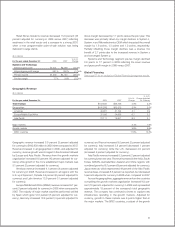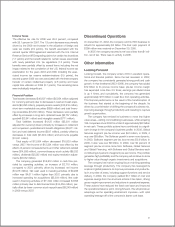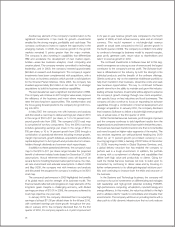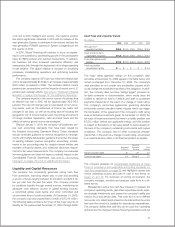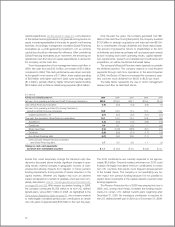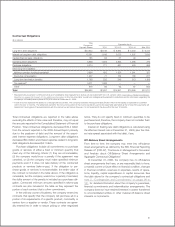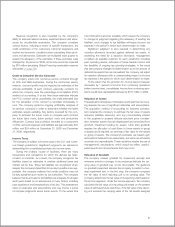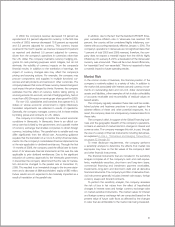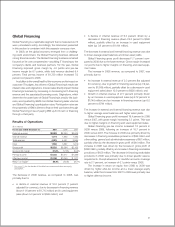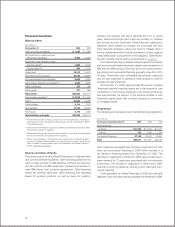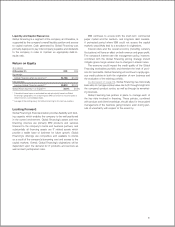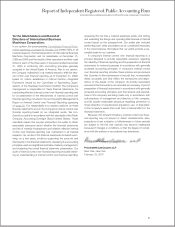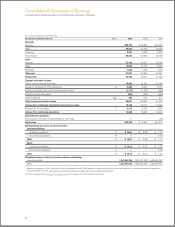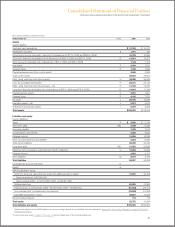IBM 2009 Annual Report Download - page 57
Download and view the complete annual report
Please find page 57 of the 2009 IBM annual report below. You can navigate through the pages in the report by either clicking on the pages listed below, or by using the keyword search tool below to find specific information within the annual report.
In 2009, the company’s revenue decreased 7.6 percent as
reported and 5.3 percent adjusted for currency. In the first nine
months of 2009, revenue decreased 10.6 percent as reported
and 5.3 percent adjusted for currency. This currency impact
reversed in the fourth quarter, as revenue increased 0.8 percent
as reported and declined 5.5 percent adjusted for currency,
driven from the company’s operations in currencies other than
the U.S. dollar. The company maintains currency hedging pro-
grams for cash planning purposes which mitigate, but do not
eliminate, the volatility of currency impacts on the company’s
financial results. In addition to the translation of earnings, the
impact of currency changes also may affect the company’s
pricing and sourcing actions. For example, the company may
procure components and supplies in multiple functional cur-
rencies and sell products and services in other currencies. The
company believes that some of these currency-based changes in
cost impact the price charged to clients. However, the company
estimates that the effect of currency, before taking pricing or
sourcing actions into account, and net of hedging activity, had no
more than a $0.09 impact on earnings per share growth in 2009.
For non-U.S. subsidiaries and branches that operate in U.S.
dollars or whose economic environment is highly inflationary,
translation adjustments are reflected in results of operations.
Generally, the company manages currency risk in these entities
by linking prices and contracts to U.S. dollars.
The company is continuing to monitor the current economic
conditions in Venezuela. In Venezuela, there is an official cur-
rency rate that is fixed by the government, and a parallel market
of currency exchange that enables companies to obtain foreign
currency, including dollars. The parallel rate is variable and may
differ significantly from the official rate. Accounting guidance
requires that the translation of a non-U.S. entity’s financial state-
ments into the company’s consolidated financial statements be
at the rate applicable to dividend remittances. Through the first
11 months of 2009, the company used the official rate for trans-
lation of its Venezuela financial statements as this was the rate
applicable to prior dividend remittances. Due to the significant
reduction of currency approvals by the Venezuela government,
in December the company determined that the rate for transla-
tion should be changed to the parallel rate at December 31,
2009. This resulted in an immaterial charge to the income state-
ment and a decrease of IBM stockholders’ equity of $93 million.
Future results are not expected to be materially impacted as a
result of translation at the parallel rate.
In addition, due to the fact that the blended CPI/NCPI three-
year cumulative inflation rate in Venezuela has reached 100
per cent, the country will be considered highly inflationary, con-
sistent with accounting standards, effective January 1, 2010. The
company’s operations in Venezuela are not significant (less than
1 percent of total 2008 and 2009 revenue), therefore, the com-
pany does not expect a material impact from the shift to highly
inflationary. On January 8, 2010, a devaluation of the Venezuelan
currency was announced. There will be a two-tiered official rate,
for “essentials” and “non-essentials”. This is not expected to have
a material impact to future operating results.
Market Risk
In the normal course of business, the financial position of the
company is routinely subject to a variety of risks. In addition to
the market risk associated with interest rate and currency move-
ments on outstanding debt and non-U.S. dollar denominated
assets and liabilities, other examples of risk include collectibility
of accounts receivable and recoverability of residual values on
leased assets.
The company regularly assesses these risks and has estab-
lished policies and business practices to protect against the
adverse effects of these and other potential exposures. As a
result, the company does not anticipate any material losses from
these risks.
The company’s debt, in support of the Global Financing busi-
ness and the geographic breadth of the company’s operations,
contains an element of market risk from changes in interest and
currency rates. The company manages this risk, in part, through
the use of a variety of financial instruments including derivatives,
as explained in note L, “Derivatives and Hedging Transactions,”
on pages 92 through 96.
To meet disclosure requirements, the company performs
a sensitivity analysis to determine the effects that market risk
exposures may have on the fair values of the company’s debt
and other financial instruments.
The financial instruments that are included in the sensitivity
analysis comprise all of the company’s cash and cash equiva-
lents, marketable securities, short-term and long-term loans,
commercial financing and installment payment receivables,
investments, long-term and short-term debt and all derivative
financial instruments. The company’s portfolio of derivative finan-
cial instruments generally includes interest rate swaps, foreign
currency swaps and forward contracts.
To perform the sensitivity analysis, the company assesses
the risk of loss in fair values from the effect of hypothetical
changes in interest rates and foreign currency exchange rates
on market-sensitive instruments. The market values for interest
and foreign currency exchange risk are computed based on the
present value of future cash flows as affected by the changes
in rates that are attributable to the market risk being measured.
55


